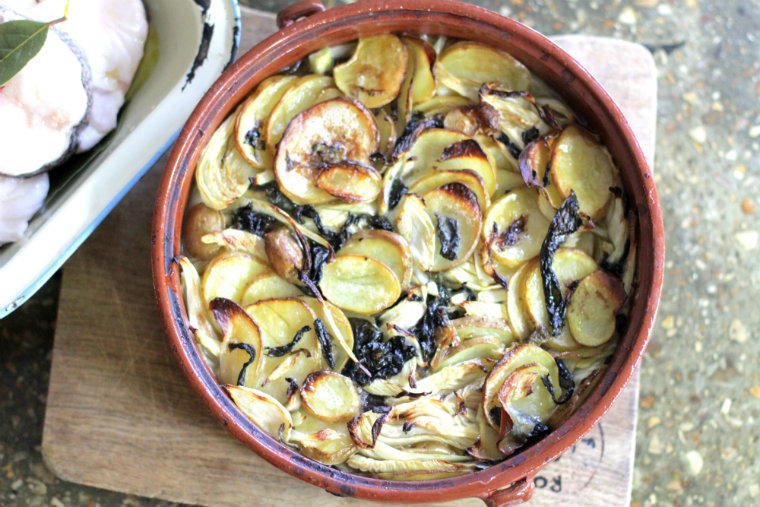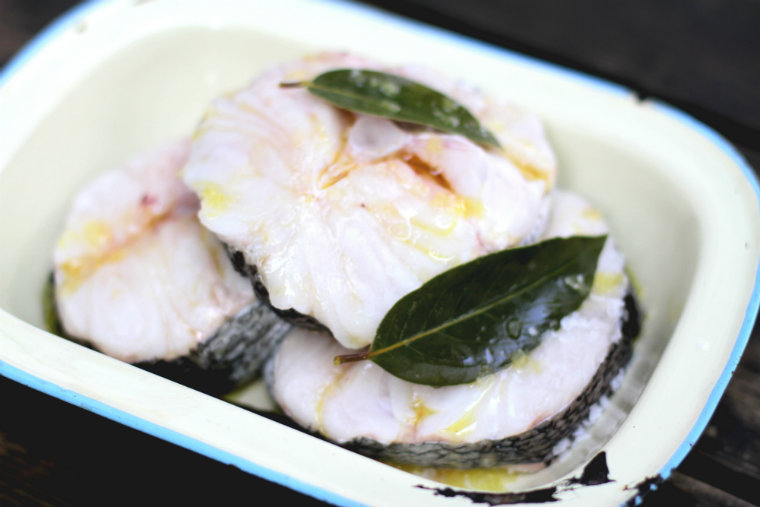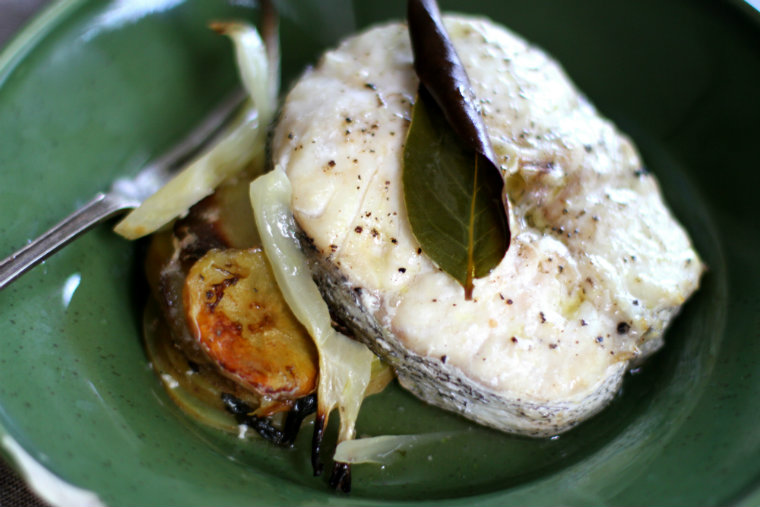October
Bracing walks, vibrant leaves, foraged mushrooms, seafood galore and hake roasted over fennel and potato gratin. Tom Hunt on what we can enjoy this season.
Autumn is here in all its glory, a time of year full of the wild and wonderful. It’s perfect for walking: the seas are cold, with tumultuous clouds hovering overhead in Turneresque, moody skies; inshore the woods are full of vibrant orange leaves, wild mushrooms and berries. I like to forage, learning as I go about which mushrooms might be edible – but I don’t trust myself to make the final decision on whether I’m holding the answer to my culinary dreams or a sore tummy (or worse).
If you’re out picking mushrooms make sure you take an expert; otherwise, take advantage of the wonderful selection of wild mushrooms at the market. Like fish, wild mushrooms need little to make them taste great. One of my favourite ways to serve them is with turbot. The farmed variety is available all year round and is a sound sustainable option, particularly since they are typically raised in enclosed land-based systems, rather than open-water pens, and so have “little or no direct environmental impact”, according to the Marine Conservation Society.
To cook, heat a heavy-based pan with a glug of olive oil and generous knob of butter to a medium temperature, add a turbot fillet and mushrooms. Leave the fillet until it starts to crisp a little, then flip and cook for a further minute. Agitate the mushrooms in the butter as they cook. Serve with parsley and some boiled potatoes for a simple, yet immensely decadent supper.
The spawning season is now over for most species of fish, which gives the seasonal and ethical eater a wider selection to choose from. The most recent fish to add to the eat list are lobster, clams, red gurnard and scallops – all delicacies of the sea. I also can’t urge you enough to take advantage of the wonderful oysters and mussels available at the moment, coming to their peak as the water cools.

Other seasonal heroes that are now available on land include beets, butternut squash, celery, celeriac, fennel, Jerusalem artichoke, kale, leeks and sweetcorn. Try inventing some new dishes of your own by pairing seasonal vegetables and fish together. A Jerusalem artichoke soup made with a hearty fish stock and some oysters served warm on top with a dash of cream would be out of this world. Or even an autumn BBQ of grilled golden corn and lobster, both smothered in salty butter and rubbed with garlic.
But my seasonal pick this month is hake, a monster of the deep (weighing as much as 15kg!), with wide eyes and sharp teeth – an efficient hunter I’m sure. Hake has a good breadth to the body, which makes it particularly suitable for cutting into steaks – brilliant for grilling. The flesh is pearly white with large soft flakes – similar to cod, but lighter. It is also a good sustainable pick as it is now prolific in our waters and mostly caught by British boats.

Hake is mostly caught using gill nets: a highly selective method, with the mesh carefully sized to catch specific fish species and reduce bycatch. In the past, gill nets have had a bad reputation for catching aquatic mammals, but my fish wholesaler Mark Matchin assures me this hasn’t happened with his fishing boats for the past decade thanks to “tingers”: ultrasound devices attached to the nets, which are incredibly effective at keeping dolphins and the like away.
The Spanish absolutely adore hake and serve it in many ways in their seaside towns. Michelin-starred chef Dani Lopez, who owns a restaurant in San Sebastian, the culinary capital of Spain, says the jowl of the hake is the best part of the fish and has a beautiful gelatinous texture – perfect for enrichening a sauce and delicious to eat too. The head of the hake will more often than not be discarded in this country, so ask your fishmonger when you buy your fillets to cut the flesh from the underside of the jaw for you to keep. I’m pretty sure he’ll throw this treat in for free – not bad for an ingredient that is served as a delicacy in Michelin-starred restaurants.
In recent years the stock quota for catching hake has almost doubled in the UK and stock levels are at their highest since the 1990s. (In fact, not so long ago hake was named “Britain’s most sustainable fish” and last June the Cornish hake fishery was certified as sustainable by the Marine Stewardship Council.) I’m sure that we’re set to see a lot more hake on our fishmongers’ counter and I intend to take advantage of this well-stocked, fairly priced, delicious fish.

Hake roasted over fennel and potato gratin
This is a flavoursome one-pot-wonder for the oven. The juices from the hake seep into the baked gratin making it all the more intense and deliciously savoury. Adding the seaweed steps this recipe up a notch, giving a fuller depth of flavour and twang that works well in contrast with the gelatinous, rich hake.
Ingredients
Makes 4 portions
200ml white wine
200ml water
200g veggies from your fridge (onion, celery, carrot, mushrooms, fennel tops, etc.)
500g fennel, keep the tops and trimmings for stock, roughly slice the bulb
400g floury potatoes, such as a King Edward or Désirée, thinly sliced
2 tbsp seaweed salad mix (optional)
1 clove garlic, peeled, finely chopped
4 hake steaks (and the meat from under the jaw, if possible)
4 bay leaves
Extra virgin olive oil
Method
Preheat the oven to 200°C. Bring the wine, water and leftover vegetables to the boil and simmer for 10 minutes. Then pass through a sieve keeping the liquid and discarding the stock trimmings.
Combine all the other ingredients, except the olive oil, in a large bowl and season generously with salt and pepper. Mix well.
Fill a baking dish about 35cm deep with the mixture, pour the stock over the top and tightly cover with foil.
Bake for 50 minutes with the foil on. Then test to see if the potatoes are soft by poking them with a knife. If they need further cooking, pop it back into the oven with the foil, otherwise remove the foil and return to the oven for 10 minutes to colour up the top.
Next place the hake directly on top of the gratin with a bay leaf tucked under each piece. Drizzle with the olive oil and season with salt and pepper. Return to the oven for 10-15 minutes, until the fish is just cooked.
Serve hot with green salad if you wish.
Tom Hunt is author of The Natural Cook: Eating the Seasons from Root to Fruit. He founded the Forgotten Feast, a campaign working on projects throughout the UK, to revive our cooking heritage and help reduce food waste and Poco, a festival café and award-winning restaurant in Bristol and London’s Broadway Market. Click here to read his blog, Tom’s Feast.





